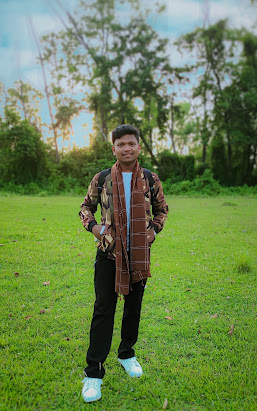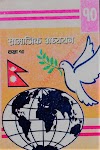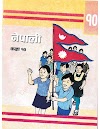Class 12 English Guide Half-Closed Eyes of Lord Buddha and Sinking sun By- Shankar Lamichhane Exercise Question Answer With Solution
6. Half-Closed Eyes of Lord Buddha and Sinking sun By- Shankar Lamichhane
Main Summary
The story entitled ' The
Half-closed Eyes of the Buddha and the Slowly Sinking Sun' deals with the monologues of two characters a tourist guide in
Kathmandu valley and a foreign tourist. The story is different from
conventional stories and, instead of showing actions and events, the story
records what the two characters think in a stream of consciousness
technique. The two major characters of this story are a western tourist
and a Nepali tourist guide.
The tourist is a confident
woman, who claims to be an expert in knowing Nepal thoroughly, even more than
the guide. She is well-versed
in Nepalese history, having read many books about it. There is an opening scene in
which a tourist describes the view of a green valley in Kathmandu. Having grown
up surrounded by plains, mountains, and the sea, she enjoys this place for its
natural scent and peacefulness.
The Buddha's half-closed eyes of
Swoyabhu Temple make her feel at ease. She also states the East's various
contributions, such as valueable tools and writings written on palm leaves or
on copperplate inscriptions from the ancient time. Then, the guide tells her
how people were able to settle in Kathmandu Valley as a result of Manjushri's sword
blow at Chobhar. As well, she
discusses different types of food, such as momo. She recalls a grandmother
telling her grandson the story of Brikuti while smoking hookah.
The second part of the story is
about the guide's feelings. On Chobhar Hill, Manjushri cut it open with his
sword to let the water out, he tells the story of Chobhar Hill's history.
On their way back, they stop in
front of a house to show her the condition of a paralyzed child what life is really like. She'd never seen
anything like it, and he wanted to show it to her. Polio had completely paralyzed
the body of that child. No physical activity is possible for him. The child's
looking is compared to the samyak gaze(A position of lord Buddha). According to
him, it's a trend only found in Easterners: the ability to remain silent and
immobile for long periods of time without complaining.
The guide tells the child's
parents that she is a doctor, which she tells a lie for the psychological
treatment. As a result, they view her as their eldest child who has come to
seek the brother's help. As a result, they become joyful. Their eyes are filled
with intimacy, kindness, and gratitude. In addition, he shows the child's
healthy sister. She could do all of her Age-appropriate activities.
They can see the shinning in the
child's eyes as his mother punishes his sister. He certainly wishes he could
say that dirty acts are pleasant, but he cannot. The guide thinks that the
tourist's eyes welcome her and hide the end of life. They are every bit as
beautiful as the setting sun's reflection in the Buddha's eyes.
Answer the following questions.
a. How does the tourist describe his initial impression
of the Kathmandu valley?
➜ The tourist describes his initial impression
of the Kathmandu valley as green, with geometric fields, earthen buildings in
red, yellow, and white, and the beautiful soil and mountains in the air.
b. According to the tourist, why is the West indebted to
the East? ( VVI)
➜ According to the tourist, the West is
indebted to the East for the pleasant atmosphere, religious and cultural
sculptures(मुर्ति), the Purans, ivory
ornaments, manuscripts (hand written) of palm leaves, inscriptions (wtiting)on
copperplate old tools, and many other things.
c. How does the tourist interpret the gaze of the monks
and nuns?
➜ The tourist interprets the gaze of the monks
and nuns as 'the samyak gaze,' which denotes pure perception; a sight that
detects everything in its genuine(original) form.
d. Why do the tourists think Nepali people are wonderful
and exceptional?
➜ The tourists think Nepali people are
wonderful and exceptional because of their ability to create exceptional wooden
images, as well as numerous ornamentations and beautiful images of gods,
enchanting music from traditional musical instruments, and hospitable behaviour
through diverse cultural and religious ceremonies.
e. What are the different kinds of communities in the
Kathmandu valley and how do they co-exist with each other?
➜ The different kinds of communities found in
the Kathmandu valley are Aryans, non-Aryans, Hindus, and Buddhists and they
co-exist with each other in harmony.
f. What does the tourist feel about the temple of
Adinath?
➜ The tourist feels the Adinath temple is a
live example of Nepalese tolerance and coexistence.
g. Why does the guide take the tourist to the remote
village?
➜ The guide takes the tourist to a remote
village to show the tourist the pulse of reality through the eyes of a farmer's
family, their hard labour, clean environment, and miserable living.
h. What does the innocent village couple think of the
doctor?
➜ The innocent village couple thinks of the
doctor as the rays of hope for life.
i. What are the differences between the paralyzed child
and his sister?
➜ The difference between the paralyzed child
and his sister is that the paralyzed child's entire body is worthless; he can't
speak or crawl, and just his eyes are living parts of his body, but the
sister's entire body operates normally. She can speak, crawl, and move her body
freely.
j. Why does the guide show the instances of poverty to
the tourist?
➜ The guide shows the instances of poverty to
the tourist so that he understands the really terrible poverty of people living
in remote locations, as well as their lack of security and modern conveniences
despite their hospitable behaviour.


.png)


.png)




.gif)



0 Comments